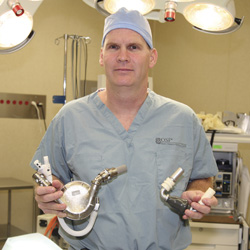
The latest generation of mechanical circulatory support devices, also known as ventricular assist devices or artificial hearts, represents a dramatic advancement in this technology and carries the potential to revolutionize future treatment for patients in advanced-stage heart failure.
This technology has evolved dramatically since cardiovascular surgeons at HeartCare Midwest began implanting mechanical circulatory support devices 14 years ago, according to Dr. Dale Mueller, a cardiovascular surgeon with that practice. The most advanced device approved by the FDA is the HeartMate II, manufactured by Thoratec, which was recently implanted for the first time in Illinois outside of Chicago. The surgery was performed by Dr. Mueller at OSF Saint Francis Heart Hospital in October.
“The device substitutes for a portion of the heart when it is failing,” Dr. Mueller explained. “Because there were longevity issues with these devices over the years, Thoratec has been working toward a device that would last longer and have a lower infection rate. And the HeartMate II is that newest device. It is a powerful rotary blood pump that provides tremendous blood flow through the circulatory system on a continual basis.”
Candidates for mechanical circulatory support devices are patients who otherwise would not survive due to advanced-stage heart failure. The devices are implanted as bridges to transplantation, meaning they keep patients alive until they can undergo heart transplants. The HeartMate II has been studied extensively as a bridge to transplantation. According to Dr. Mueller, the majority of the 194 patients involved in a study conducted from March 2005 to September 2006 “demonstrated vast improvement, progressing from severe heart failure symptoms, even at rest, to being able to resume normal activities with little or no limitation.”
Dr. Mueller reports that his first HeartMate II patient, a 40-year-old male, initially presented with “horrific heart failure” and was unable to walk prior to his device implant, but is now discharged and walking considerable distances at home.
The cardiovascular surgeon expects that the HeartMate II will also be approved for what is known as “destination therapy.” “This means that a patient’s destination is to get a device, and that’s what he or she lives with rather than looking at a heart transplant,” he said. Destination therapy is for patients who do not want heart transplants or do not qualify for transplantation due to age or medical condition. Results of a clinical trial evaluating the efficacy and safety of HeartMate II destination therapy will be available in the spring.
“There are some people who believe that this device will take over for heart transplants,” Dr. Mueller said. “There are a limited number of donors and organs, and there are people who die waiting for heart transplants. The HeartMate II is designed to dramatically improve survival and quality of life and was developed with the goal of providing up to 10 years of circulatory support for a broad range of advanced heart failure patients.”
Advantages of the HeartMate II over previous generations of artificial hearts include its small size. Weighing 12 ounces and measuring 1.5 inches in diameter and 2.5 inches in length, it is significantly smaller than other similar devices. As a result, it can be implanted in a wider range of patients, including children and small adults.
“Despite its size, it’s a very powerful pump,” Dr. Mueller said. “In our first HeartMate II patient, we have flows of eight to nine liters per minute, which is extraordinary compared with flows of four to five liters per minute with the other devices.”
The size of the batteries required to power the device has also decreased dramatically over the years. The original device had a battery unit on wheels that was the size of a riding lawn mower. The HeartMate I has a battery pack that patients have to carry. For the HeartMate II, small batteries are attached to each side of the patient’s chest.
Another advantage of the HeartMate II is that it requires a less invasive surgical procedure to implant it, resulting in a shorter operation, reduced risk of bleeding and quicker recovery.
Furthermore, should the HeartMate II need to be replaced, the replacement procedure is relatively simple, compared to that for older versions of artificial hearts. “We had to open the breast bone again to switch out the bigger generation of the device,” Dr. Mueller said. “The HeartMate II lies right under the rib cage and is dramatically easier to replace.”
The cardiovascular surgeon anticipates that artificial hearts will continue to be refined in coming years, which is good news for patients in advanced-stage heart failure.
“There are approximately five million Americans who suffer from congestive heart failure, with another half million diagnosed each year,” he said. “Ventricular assist devices offer new hope and a much greater quality of life for these individuals.” iBi

